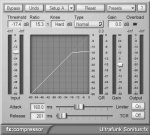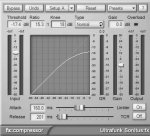Hi guys,
I have read several resources on compression but i am struggling to get a grasp on the concept. I am a little confused about the attack and release settings on a compressor. I would be grateful if someone could take the time to help me on this one.
Lets say i have a compressor with the follwing settings. Attack 10ms and release 20ms and my input signal is above te threshold setting for 50ms.
Please could someone explain how long the compressor will be working for.
Is the following statement true:
As soon as the input signal reaches the threshold the compressor starts working but it takes 10ms for it to get from 0 gain reduction to the amount of gain reduction as set by the ratio control. As soon as the signal drops below the threshold the compressor will stop working but it will take 20ms for it to get from the ratio setting to 0 compression.
What would happen if the attack was 100ms?
Would the compressor never actually reach the gain reduction as set by the ratio control because the release would start half way through the attack phase, or would it still reach full compression after 100ms and then the release phase would start.
How does the hard and soft knee settings effect all this??
Thank you very much anyone who takes the time to explain this.
Keith
I have read several resources on compression but i am struggling to get a grasp on the concept. I am a little confused about the attack and release settings on a compressor. I would be grateful if someone could take the time to help me on this one.
Lets say i have a compressor with the follwing settings. Attack 10ms and release 20ms and my input signal is above te threshold setting for 50ms.
Please could someone explain how long the compressor will be working for.
Is the following statement true:
As soon as the input signal reaches the threshold the compressor starts working but it takes 10ms for it to get from 0 gain reduction to the amount of gain reduction as set by the ratio control. As soon as the signal drops below the threshold the compressor will stop working but it will take 20ms for it to get from the ratio setting to 0 compression.
What would happen if the attack was 100ms?
Would the compressor never actually reach the gain reduction as set by the ratio control because the release would start half way through the attack phase, or would it still reach full compression after 100ms and then the release phase would start.
How does the hard and soft knee settings effect all this??
Thank you very much anyone who takes the time to explain this.
Keith


